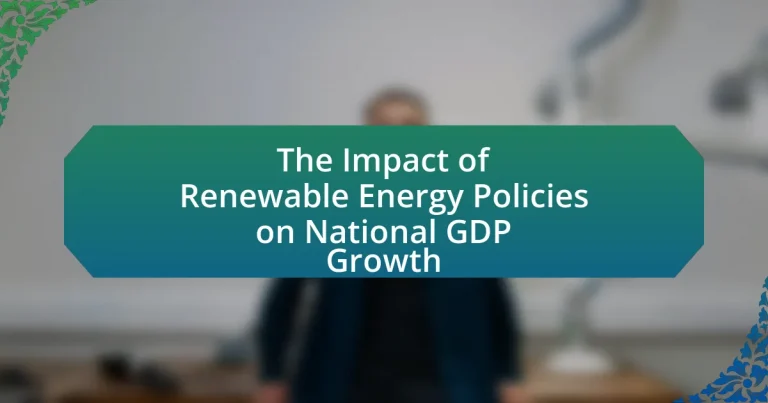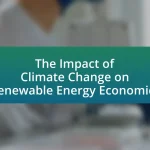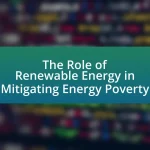Renewable energy policies are regulations and initiatives aimed at promoting the development and utilization of renewable energy sources, such as solar and wind, with objectives including reducing greenhouse gas emissions, enhancing energy security, and fostering economic growth through job creation. These policies significantly influence national GDP growth by attracting investments, creating jobs, and stimulating innovation in clean energy technologies. The article explores the specific goals of these policies, their varying implementations across different nations, and the metrics used to measure their economic impact. Additionally, it addresses the challenges faced in effectively implementing these policies and highlights best practices from successful countries to maximize their positive effects on GDP growth.
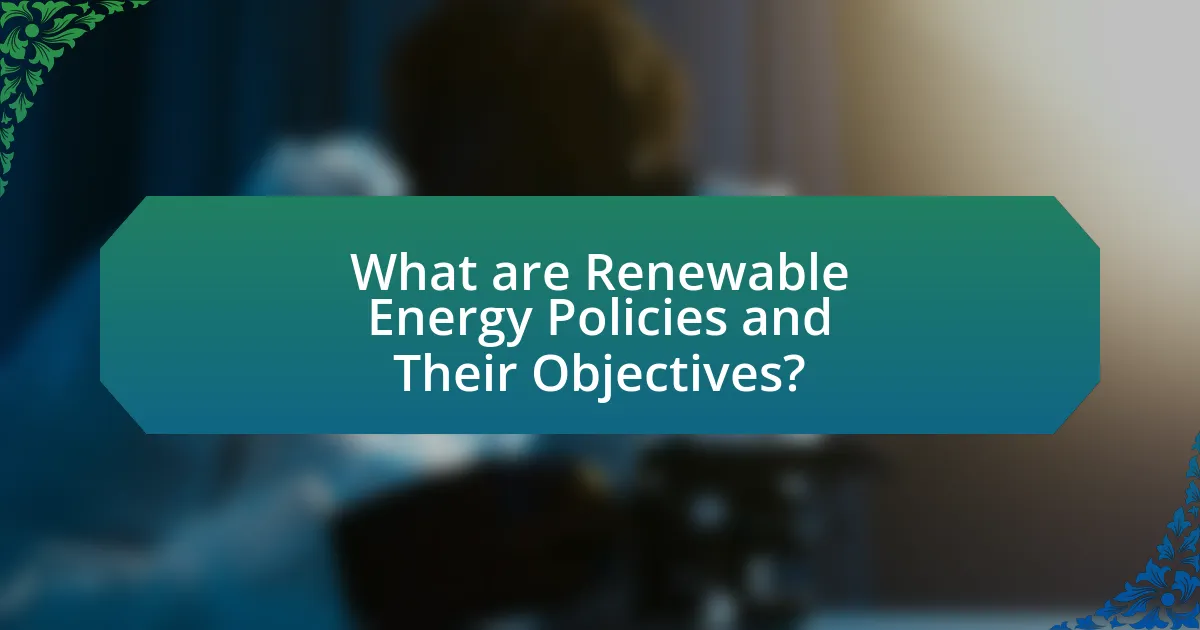
What are Renewable Energy Policies and Their Objectives?
Renewable energy policies are regulations and initiatives designed to promote the development and use of renewable energy sources such as solar, wind, and biomass. Their primary objectives include reducing greenhouse gas emissions, enhancing energy security, and fostering economic growth through job creation in the renewable sector. For instance, the International Renewable Energy Agency reported that renewable energy jobs reached 11.5 million globally in 2018, demonstrating the economic potential of these policies. Additionally, these policies aim to decrease reliance on fossil fuels, thereby mitigating the impacts of climate change and promoting sustainable development.
How do Renewable Energy Policies influence economic growth?
Renewable energy policies significantly influence economic growth by promoting investment in clean energy technologies, which creates jobs and stimulates innovation. For instance, countries that implement supportive policies, such as tax incentives and subsidies for renewable energy projects, often experience increased private sector investment. According to a report by the International Renewable Energy Agency (IRENA), the renewable energy sector employed over 11 million people globally in 2018, demonstrating the job creation potential linked to these policies. Furthermore, transitioning to renewable energy can reduce dependence on imported fossil fuels, leading to improved trade balances and energy security, which further supports economic stability and growth.
What specific goals do these policies aim to achieve?
The specific goals of renewable energy policies aim to increase national GDP growth by promoting sustainable energy sources, reducing dependency on fossil fuels, and enhancing energy security. These policies are designed to stimulate economic activity through job creation in the renewable energy sector, which has been shown to generate more jobs per unit of energy produced compared to fossil fuels. For instance, a report by the International Renewable Energy Agency (IRENA) indicates that the renewable energy sector employed 11.5 million people globally in 2018, contributing significantly to economic growth. Additionally, these policies seek to lower greenhouse gas emissions, which can lead to long-term cost savings and health benefits, further supporting GDP growth.
How do these policies vary across different nations?
Renewable energy policies vary significantly across nations, influenced by factors such as economic structure, resource availability, and political will. For instance, countries like Germany and Denmark have implemented aggressive renewable energy targets and substantial subsidies, resulting in a significant increase in their GDP growth linked to green technology sectors. In contrast, nations like the United States exhibit a more fragmented approach, with policies varying by state, leading to inconsistent impacts on GDP growth. According to the International Renewable Energy Agency (IRENA), countries that invest heavily in renewable energy, such as China, have seen GDP growth rates increase by up to 7% due to job creation in the renewable sector. This evidence illustrates that the extent and effectiveness of renewable energy policies directly correlate with national economic performance.
Why is the relationship between Renewable Energy Policies and GDP important?
The relationship between Renewable Energy Policies and GDP is important because effective policies can drive economic growth by fostering innovation, creating jobs, and attracting investments in the renewable energy sector. For instance, a study by the International Renewable Energy Agency (IRENA) found that the renewable energy sector employed over 11 million people globally in 2018, demonstrating the potential for job creation linked to supportive policies. Furthermore, countries that implement strong renewable energy policies often experience increased energy security and reduced dependence on fossil fuels, which can stabilize their economies. This correlation highlights how strategic investments in renewable energy can enhance GDP growth while addressing environmental concerns.
What metrics are used to measure GDP growth in relation to these policies?
The primary metrics used to measure GDP growth in relation to renewable energy policies include Gross Domestic Product (GDP) growth rate, investment in renewable energy, employment in the renewable sector, and energy productivity. The GDP growth rate quantifies the overall economic performance, while investment in renewable energy reflects the financial commitment to sustainable practices, which can stimulate economic activity. Employment in the renewable sector indicates job creation and economic diversification, contributing to GDP. Energy productivity measures the efficiency of energy use in relation to economic output, highlighting the effectiveness of renewable policies in enhancing economic growth. These metrics collectively provide a comprehensive view of how renewable energy policies influence national GDP growth.
How do Renewable Energy Policies impact employment rates and productivity?
Renewable energy policies significantly enhance employment rates and productivity by fostering job creation in the green energy sector. For instance, a report by the International Renewable Energy Agency (IRENA) indicates that the renewable energy sector employed over 11 million people globally in 2018, with projections suggesting this number could rise to 24 million by 2030 due to supportive policies. These policies stimulate investment in renewable technologies, leading to increased production efficiency and innovation. Furthermore, a study published in the journal “Energy Policy” found that countries with robust renewable energy policies experienced higher productivity growth rates, as investments in clean energy infrastructure often lead to advancements in technology and operational efficiencies.
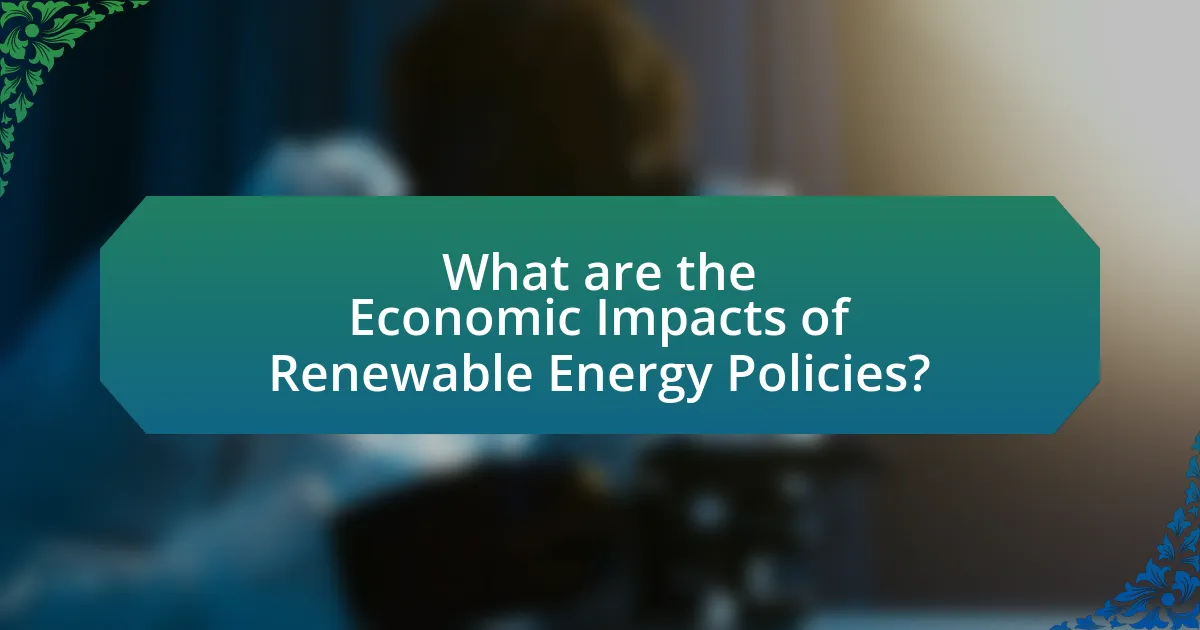
What are the Economic Impacts of Renewable Energy Policies?
Renewable energy policies significantly influence economic growth by promoting job creation, enhancing energy security, and stimulating technological innovation. For instance, the International Renewable Energy Agency reported that the renewable energy sector employed over 11 million people globally in 2018, a number that has continued to rise as investments in clean energy increase. Additionally, countries that implement renewable energy policies often experience reduced dependence on imported fossil fuels, which can stabilize national economies and improve trade balances. Furthermore, investments in renewable technologies can lead to advancements in efficiency and cost reductions, contributing to overall GDP growth. According to a study by the World Bank, countries that adopted renewable energy policies saw an average GDP growth increase of 1.5% over a decade compared to those that did not prioritize such initiatives.
How do these policies affect investment in renewable energy sectors?
Renewable energy policies significantly enhance investment in renewable energy sectors by providing financial incentives, regulatory support, and market stability. For instance, countries that implement feed-in tariffs or tax credits often see increased capital flow into solar and wind projects, as these policies reduce the financial risks associated with such investments. According to a report by the International Renewable Energy Agency (IRENA), global investment in renewable energy reached $282 billion in 2019, largely driven by supportive government policies. This demonstrates that effective policy frameworks can create a conducive environment for investors, leading to substantial growth in renewable energy sectors.
What types of investments are most influenced by these policies?
Renewable energy investments are most influenced by renewable energy policies. These policies, such as tax incentives, subsidies, and regulatory frameworks, directly encourage investments in solar, wind, and other renewable energy technologies. For instance, the U.S. Investment Tax Credit (ITC) has significantly boosted solar energy investments, leading to a 167% increase in solar capacity from 2015 to 2020. Similarly, wind energy investments have surged due to federal production tax credits, resulting in the U.S. becoming one of the largest producers of wind energy globally.
How do government incentives shape investment trends?
Government incentives significantly shape investment trends by directing capital towards specific sectors, particularly renewable energy. For instance, tax credits, subsidies, and grants encourage businesses and investors to allocate resources to renewable energy projects, thereby increasing investment in solar, wind, and other sustainable technologies. According to a report by the International Renewable Energy Agency (IRENA), global investments in renewable energy reached $300 billion in 2020, largely driven by favorable government policies. These incentives not only stimulate immediate investment but also create long-term market stability, attracting further capital and fostering innovation within the renewable energy sector.
What role do Renewable Energy Policies play in job creation?
Renewable Energy Policies significantly contribute to job creation by fostering investment in clean energy sectors. These policies, such as tax incentives and renewable energy mandates, stimulate the development of solar, wind, and other renewable technologies, leading to the establishment of new companies and expansion of existing ones. For instance, a report by the International Renewable Energy Agency (IRENA) indicated that the renewable energy sector employed over 11 million people globally in 2018, with projections suggesting continued growth as policies evolve. This job creation spans various roles, including manufacturing, installation, and maintenance of renewable energy systems, thereby enhancing local economies and reducing unemployment rates.
Which sectors see the most job growth due to these policies?
The sectors that see the most job growth due to renewable energy policies are renewable energy generation, energy efficiency, and electric vehicle manufacturing. These sectors benefit from increased investments and government incentives aimed at reducing carbon emissions and promoting sustainable practices. For instance, the U.S. Bureau of Labor Statistics projects that employment in solar photovoltaic installers will grow by 61% from 2020 to 2030, significantly outpacing the average for all occupations. Additionally, energy efficiency initiatives have led to a surge in jobs related to building retrofitting and energy auditing, further contributing to job growth in this area.
How do job creation rates compare to traditional energy sectors?
Job creation rates in renewable energy sectors generally exceed those in traditional energy sectors. For instance, the International Renewable Energy Agency reported that in 2020, renewable energy sectors employed 11.5 million people globally, while traditional fossil fuel sectors employed approximately 12 million. However, the growth rate in renewable energy jobs has been significantly higher, with a 6% increase in 2019 compared to a decline in fossil fuel jobs. This trend indicates that as renewable energy policies are implemented, job creation in these sectors is likely to continue outpacing that of traditional energy sectors, contributing positively to national GDP growth.

What Challenges Do Renewable Energy Policies Face in Contributing to GDP Growth?
Renewable energy policies face several challenges in contributing to GDP growth, primarily including high initial investment costs, regulatory hurdles, and market volatility. High initial investment costs deter both public and private sector participation, as significant capital is required for infrastructure development and technology deployment. Regulatory hurdles, such as inconsistent policies and lack of clear frameworks, create uncertainty for investors, impacting their willingness to commit resources. Additionally, market volatility, influenced by fluctuating energy prices and competition from fossil fuels, can undermine the economic viability of renewable energy projects. These factors collectively hinder the potential of renewable energy policies to drive substantial GDP growth.
What are the common barriers to effective implementation of these policies?
Common barriers to effective implementation of renewable energy policies include inadequate funding, lack of political will, and insufficient infrastructure. Inadequate funding often results from competing budget priorities, limiting the resources available for renewable energy projects. Lack of political will can stem from resistance to change among policymakers or vested interests in fossil fuels, which can hinder the adoption of progressive energy policies. Insufficient infrastructure, such as outdated power grids, can impede the integration of renewable energy sources, making it difficult to realize their full potential. According to a report by the International Renewable Energy Agency, these barriers significantly affect the pace at which countries can transition to renewable energy, ultimately impacting their GDP growth.
How do political and economic factors hinder policy effectiveness?
Political and economic factors hinder policy effectiveness by creating instability and uncertainty that can disrupt the implementation of renewable energy initiatives. For instance, political opposition can lead to inconsistent policy frameworks, as seen in countries where changes in government result in the reversal of renewable energy commitments, undermining investor confidence. Economically, fluctuations in funding availability and market conditions can limit the resources allocated to renewable energy projects, as evidenced by the decline in investment during economic downturns, which can stall progress and reduce the overall impact on GDP growth.
What role does public perception play in the success of these policies?
Public perception significantly influences the success of renewable energy policies by shaping public support and acceptance. When the public views these policies favorably, it leads to increased political backing, funding, and implementation efficiency. For instance, a 2021 survey by the Pew Research Center found that 79% of Americans support expanding solar panel use, indicating that positive public perception can drive policy adoption and investment in renewable energy. Conversely, negative perceptions can result in resistance, protests, or reduced funding, ultimately hindering the effectiveness of these policies. Thus, public perception acts as a critical determinant in the successful execution and sustainability of renewable energy initiatives.
How can countries overcome challenges to maximize GDP growth from Renewable Energy Policies?
Countries can overcome challenges to maximize GDP growth from renewable energy policies by implementing comprehensive regulatory frameworks, investing in technology, and fostering public-private partnerships. Comprehensive regulatory frameworks create a stable environment for investment, as seen in Germany’s Energiewende, which has led to significant job creation and economic growth. Investing in technology, such as solar and wind energy innovations, can enhance efficiency and reduce costs, evidenced by the 80% drop in solar panel prices since 2010, which has spurred market growth. Additionally, fostering public-private partnerships can leverage resources and expertise, as demonstrated by the collaboration between the U.S. Department of Energy and private companies, resulting in advancements in renewable energy technologies and increased economic output.
What best practices can be adopted from successful nations?
Successful nations adopt best practices such as comprehensive renewable energy policies, investment in technology, and public-private partnerships to enhance GDP growth. For instance, Germany’s Energiewende policy emphasizes transitioning to renewable energy sources, which has led to a significant increase in green jobs and economic growth, contributing to a 1.5% annual GDP increase in the renewable sector from 2010 to 2019. Additionally, Denmark’s investment in wind energy has resulted in wind power contributing to 47% of its electricity consumption in 2019, showcasing how strategic investments can drive economic performance. These examples illustrate that effective renewable energy policies can stimulate economic growth while promoting sustainability.
How can collaboration between sectors enhance policy effectiveness?
Collaboration between sectors enhances policy effectiveness by fostering comprehensive approaches that integrate diverse expertise and resources. For instance, when government agencies partner with private companies and non-profit organizations in renewable energy initiatives, they can leverage technological innovations and funding opportunities that improve policy implementation. A study by the International Renewable Energy Agency (IRENA) found that collaborative efforts in renewable energy projects can lead to a 30% increase in project efficiency, demonstrating that cross-sector partnerships can significantly enhance the effectiveness of policies aimed at promoting renewable energy and, consequently, stimulate national GDP growth.
What are the future trends in Renewable Energy Policies and their economic impact?
Future trends in renewable energy policies include increased government incentives for clean energy technologies, stricter emissions regulations, and a shift towards decentralized energy systems. These policies are expected to drive economic growth by creating jobs in the renewable sector, reducing energy costs, and enhancing energy security. For instance, the International Renewable Energy Agency reported that the renewable energy sector employed over 11 million people globally in 2018, with projections indicating this number could rise significantly as investments in renewables increase. Additionally, the transition to renewable energy is anticipated to contribute to GDP growth by fostering innovation and attracting investments, as evidenced by the U.S. Department of Energy’s findings that every $1 million invested in renewable energy creates approximately 7.5 jobs, compared to 2.65 jobs in fossil fuels.
How might technological advancements influence these policies?
Technological advancements can significantly influence renewable energy policies by enhancing efficiency and reducing costs. For instance, innovations in solar panel technology have led to a decrease in the cost of solar energy production by over 80% since 2010, making it more competitive with fossil fuels. This cost reduction encourages governments to implement more favorable policies that promote renewable energy adoption, ultimately contributing to GDP growth. Additionally, advancements in energy storage technologies, such as lithium-ion batteries, improve the reliability of renewable energy sources, prompting policymakers to invest in infrastructure that supports these technologies. This investment can stimulate economic activity and job creation in the renewable energy sector, further impacting national GDP positively.
What predictions can be made about the long-term effects on GDP growth?
Long-term effects on GDP growth due to renewable energy policies are predicted to be positive, as these policies can stimulate economic activity and create jobs. For instance, a study by the International Renewable Energy Agency (IRENA) found that transitioning to renewable energy could increase global GDP by up to 2.5% by 2050, driven by investments in clean energy technologies and infrastructure. Additionally, countries that adopt renewable energy policies often experience enhanced energy security and reduced dependence on fossil fuels, which can lead to more stable economic growth.
What practical steps can nations take to enhance the impact of Renewable Energy Policies on GDP?
Nations can enhance the impact of Renewable Energy Policies on GDP by implementing comprehensive incentives for renewable energy investments. These incentives can include tax credits, grants, and subsidies that lower the financial barriers for businesses and consumers to adopt renewable technologies. For instance, the U.S. solar investment tax credit has led to a significant increase in solar installations, contributing to job creation and economic growth, with the solar industry employing over 250,000 workers as of 2021.
Additionally, nations should invest in research and development to foster innovation in renewable technologies, which can lead to more efficient energy solutions and lower costs. The International Renewable Energy Agency reported that every dollar invested in renewable energy R&D can yield up to $7 in economic returns.
Furthermore, establishing clear regulatory frameworks and long-term energy policies can provide stability and predictability for investors, encouraging more capital flow into the renewable sector. Countries like Germany have successfully implemented feed-in tariffs that guarantee fixed payments for renewable energy producers, resulting in a robust renewable energy market and significant contributions to GDP growth.
By combining financial incentives, R&D investment, and stable regulatory environments, nations can effectively enhance the impact of Renewable Energy Policies on their GDP.
